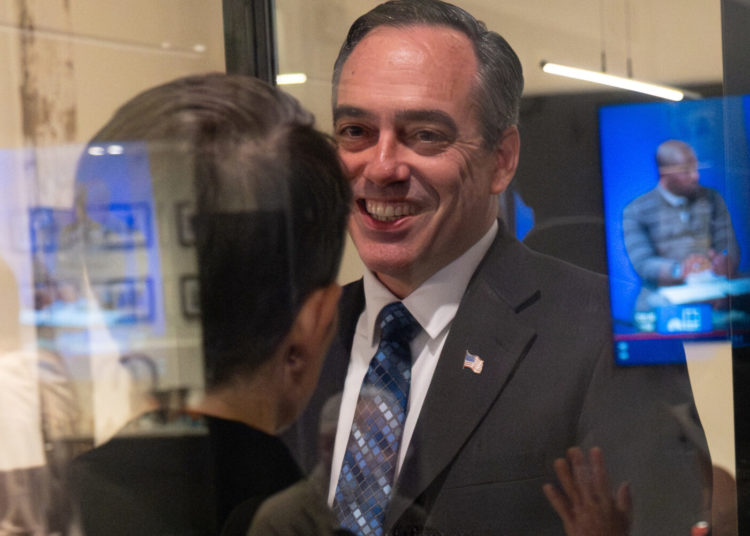The eyes aren’t just a window into the soul — they can also tell doctors a lot about what’s happening in the rest of our body. Why, then, do I have separate insurance cards for my medical and vision care?
It’s another oddity of US health care, a system that nobody would necessarily design on purpose but one we’re nevertheless stuck with. During open enrollment this year, you might be able to sign up for a vision plan through your work for, say, $10 per month or so — if you’re lucky.
But for many Americans, vision insurance simply isn’t an option: Less than 30 percent of US workers are offered vision benefits, according to the Bureau of Labor Statistics.
If you’re on Medicaid, whether you can receive vision care depends on the state you live in. Patients on the traditional Medicare program, meanwhile, have no vision benefits unless they purchase them separately; the patients who sign up for a Medicare Advantage plan might be able to get vision benefits — at an additional cost.
All of this means that most of the US population doesn’t have access to a routine eye examination covered by insurance.
The problem, as with dental insurance, is that the US health system has been built piecemeal over many decades. It wasn’t rationally designed. American health insurance started with hospital-only plans a century ago, and under that nascent system, even routine doctor visits were paid for out of pocket. As routine services grew more and more expensive over the decades, everything from prescription drugs to primary care visits was added to the standard suite of insurance benefits. But that never encompassed vision or dental care.
And then, separate from all of this, a cottage industry of discount plans for dental and vision services blossomed. In the 1950s, one group of optometrists in California started offering discount plans to their customers — a novel but flawed model for covering some of people’s vision care costs that spread across the country. And that is more or less how vision insurance works today: It’s a discount on eye exams and glasses, not a comprehensive insurance product that protects you from exorbitant costs.
But it’s not working for many people: Most Americans, especially middle-class and working-class families, don’t receive vision benefits through their work, and to purchase a vision care plan on your own is another $30 to $50 per month for people who may not have a lot of disposable income. About 25 percent of Americans said in a KFF survey that they had skipped vision care that they needed because of the costs.
Making matters worse, the vision care industry is extremely consolidated: One company may provide your eye benefits, employ your eye doctor, and sell your eyeglasses. While alternative eye care providers like Warby Parker have come onto the scene, glasses can still cost hundreds of dollars without vision benefits.
These issues are about to get a lot worse. Research shows Americans have been spending more of their money on vision-related services over the past decade. America also has a sizable aging population as the baby boomer, Gen X, and millennial generations push into retirement and their middle-aged years. The number of Americans with vision problems is expected to double from 12 million to 24 million by 2050. But younger people today are also experiencing more vision problems than previous generations — possibly because of increased screen time and less time spent outside — according to recent research.
We have to figure out a better way to protect our peepers.
A better vision for eye insurance
Vision coverage in the US is currently defined by its inequities.
Its benefits, for those lucky enough to have them, are not distributed equally. High-wage white-collar workers are more likely to be offered vision benefits than low-wage workers in the service industries. And within the federal health care system, it varies a lot, too: All states offer vision coverage to low-income kids on Medicaid, and some states offer robust vision benefits to adults on Medicaid, too, but others do not. Within the Medicare system, most plans don’t cover routine eye exams or new frames. But for people who sign up for an alternative Medicare Advantage plan — Americans 65 and older who are more likely to be higher-income — typically have vision care covered as part of that plan, though it can have substantial cost-sharing requirements.
This patchwork system turns having vision insurance into a game of luck. Did your company have a good year last year, so they can keep offering vision benefits? Or will they have to cut them if the economy turns south? We see the same pattern in Medicaid: States are generous with their vision coverage — but only when they can afford to be. As of 2022, as many as 15 million adults lived in states that did not provide comprehensive eye exam and eyeglasses coverage.
“States add and drop these benefits partly based on budgetary conditions,” Brandy Lipton, a health economist at University of California Irvine, told me. “If they’re seeing some extra funds, then they may add them in. And if they’re struggling a little bit or experiencing higher enrollment than expected and things like that, they might take them away.”
This is the problem with the system we have set up: Your ability to get vision care can change in an instant if your state decides to take away your Medicaid benefits, or if you change jobs and no longer receive a vision plan. And when people lose their benefits, most stop getting their eyes checked. That means their vision problems will get worse — and doctors could, at the same time, miss an opportunity to identify early problems with diabetes or heart disease. Damage to the tiny blood vessels in your eyes can be evidence of more widespread cardiovascular problems. Given all the cracks in vision coverage, a lot of people are going to fall through.
And when they do, the consequences are serious. Vision care is effective, if you can get it: A study published in JAMA Ophthalmology found that people who received vision services simply maintained better vision throughout their lives. They were more likely to be able to recognize friends across the street and read printed materials than people who did not, and those who had a serious eye disease saw the same benefits to their sight when receiving routine vision care.
But more than that, routine eye examinations offer physicians a chance to see what’s happening all over your body, not just inside your eyeballs.
Poor vision and eye issues can give clues about whether someone might develop other conditions, like heart disease, diabetes, or high cholesterol and blood pressure. Vision issues, too, can be linked with depression.
“During a routine eye exam, there’s a lot that an eye care professional can see about your health,” Lipton said. “That’s potentially a missed opportunity if people aren’t getting routine eye exams and to have that extra contact with the health care system and potentially get a diagnosis.”
It could even be a boon to the employers who offer vision benefits: Lipton and University of Maryland researcher Michel Boudreaux studied what had happened with working-age Medicaid patients when they were offered vision benefits from 2003 to 2012, using federal survey data, They found that workers were able to work more hours and work higher-skill jobs when they received regular eye care.
But at least so far, improving vision insurance has been an afterthought in US health care reform. Sen. Bernie Sanders (I-VT) has introduced bills that would require Medicare to cover vision care for people in the traditional program, but otherwise, there aren’t currently any serious proposals to integrate vision services into conventional health coverage on the table.
Other developed countries offer a few potential fixes. In Germany, for example, eye exams are covered by health insurance plans, but you have to pay for your own eyeglasses or contacts. In France, many people can receive simple thin black frames for free; it is only if you decide you want designer shades or something more stylish that you have to pay out of pocket for your glasses.
The gaps in the current American system and the potential benefits of more people receiving vision care should be obvious. US health policy has been an ongoing struggle to patch up the holes in our makeshift system. Extending vision benefits to more people would be an easy win.
The post We can fix the goofy way we pay for vision care in the US appeared first on Vox.




